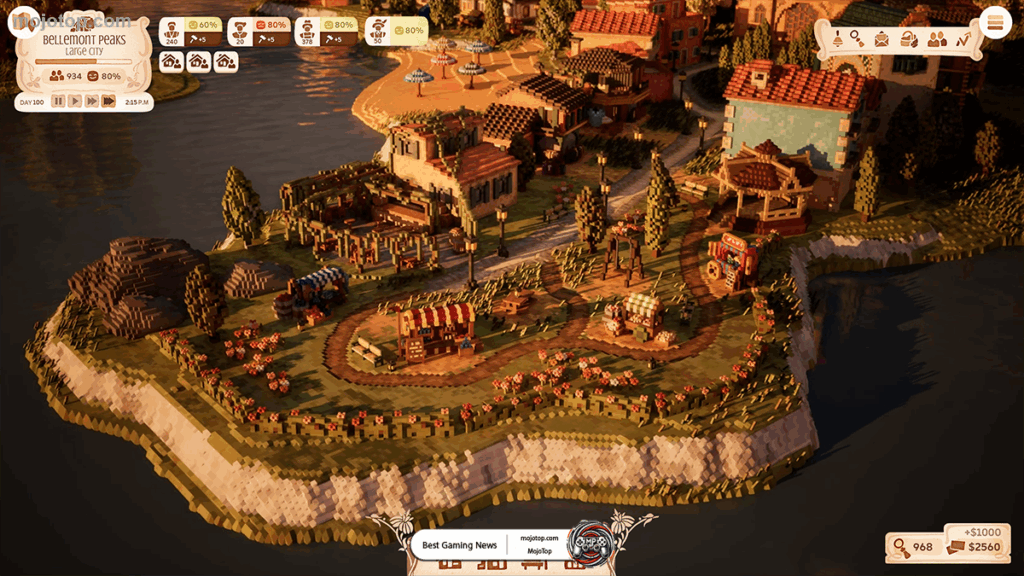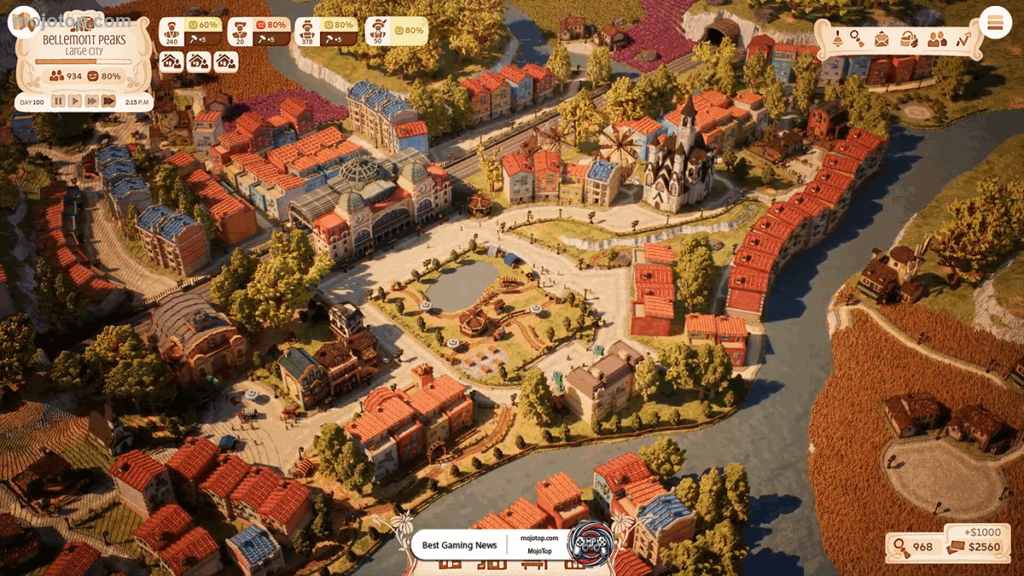Town to City: 4 Steps From Dust to Digital Empire
Dive into Town to City and explore how simple voxel blocks evolve into bustling cities. From building mechanics to economy, get the latest town to city news.
Town to City is an upcoming voxel art city builder developed by Galaxy Grove and published by Kwalee. Players begin with a modest plot of land in a 19th-century Mediterranean-inspired setting and are given the freedom to build, customise, and expand without being constrained to a strict grid.
One of the standout features is the grid-less building system, which allows you to draw roads, place houses, shops, amenities, parks, and natural elements wherever you like. This flexibility encourages creative layouts and organic growth as your town gradually becomes a bustling city.
Along with sandbox mode, Town to City includes full campaign mode, where the pace of development is more guided and structured. As you progress, you’ll need to balance citizen satisfaction, resource management, economic growth, and decorative choices to foster population growth.
If you are interested in PC games, make sure to explore our other related articles.
According to recent town to city news, the game is set to launch in Early Access on September 16, 2025. Until then, a free demo is available via Steam, allowing players to test the core building mechanics, share feedback, and get involved in community conversations.
Key features confirmed in town to city news include modular decorations, a photo mode, a tech tree for researching new buildings and customization, and citizen management systems including jobs and happiness tracking.
Overall, Town to City promises a relaxed yet richly detailed building experience where creativity meets strategy. The recent town to city news shows the developers are committed to polishing the game through community input during Early Access, with plans for additional content, balancing, and quality-of-life improvements leading up to version 1.0.

From Dust to a Small Town
In Town to City, the journey from barren land to the heart of a lively small town is where players’ creativity and planning begin to truly matter. At the very start, you are given a blank plot — often with just a train station, few basic roads, minimal infrastructure, and natural terrain. From that humble beginning, players slowly assemble the essentials: housing, shops, amenities, and decorative features, all without the constraints of a grid. This freedom lets each settlement feel organic, whether you build winding roads or clustered districts. (Steam store info, developer communications)
Citizen satisfaction is more than just aesthetics. Early in Town to City, you must balance necessities like food, jobs, and services. Workers need employment, citizens require amenities and happiness, and buildings need to be placed efficiently to support growth. This small-town phase introduces basic mechanics for town and citizen management that become crucial later.
Recent town to city news confirms the game’s Early Access release date of September 16, 2025. This era will offer players the chance to experiment with small town layouts, test out sandbox mode, and provide feedback on how the game feels in its foundational phase. The demo version allows a peek at road tools, modular decorations, and citizen happiness systems in action.
In summary, the “dust to small town” stage in Town to City is about establishing groundwork: laying infrastructure, attracting citizens, and balancing basic growth. It sets the tone, both visually and mechanically, for how players will mould their cities into unique creations. Observing town to city news during this phase gives insight into community responses, development adjustments, and the evolving tools that will shape every town’s identity.
Growth and Community Expansion
As Town to City moves out of the initial building stage, growth and community expansion become central to the experience. This phase is where your small town begins to transform: population increases, economic systems evolve, and citizen needs grow more complex. According to recent town to city news, the game’s Early Access release date is set for September 16, 2025, giving players a chance to engage with these systems in real time.
One of the key elements in growth is population management. As more citizens arrive, you must ensure there are enough jobs, housing, and services to keep them content. Happiness mechanics play a role: completing tasks from townsfolk, providing decorative amenities, and balancing basic services like sanitation, food, and civic infrastructure all feed into satisfaction levels. The game’s design encourages expanding gradually, making sure that growth does not outstrip your capacity to maintain a functioning, livable town.
Economic expansion is another pillar. As your town grows, more types of buildings unlock—shops, entertainment, cultural landmarks—all contributing to a more diverse economy. Town to City allows free placement of buildings without grid restriction, which means that as you expand, there is room for creative district layouts, mixed-use spaces, and visually distinctive neighborhoods. These are not just cosmetic: they affect how efficiently services operate, how happy your citizens are, and how quickly your town attracts even more people.
Another aspect in community expansion is unlocking advanced features and customization. town to city news reveals that modular decoration options, a photo mode, and more refined tools for citizen job assignment and happiness tracking are being developed and refined. Players will be able to respond to feedback during Early Access, tailoring how neighborhoods grow, adjusting aesthetics, and improving quality-of-life for citizens.
Finally, community involvement and feedback are shaping how growth is implemented. The demo released as part of Steam’s Next Fest and the public interactions via the game’s Steam community and Discord have provided developers with direct input on which growth features need tweaking—such as how large expansions feel, how citizens’ demands escalate, and how tools for service management behave in larger town settings. Following town to city news gives early adopters insight into upcoming patches, balancing changes, and new content aimed at enhancing the expansion phase
Rise to a Digital Empire
In Town to City, the late game transformation from a flourishing town into a sprawling digital empire is where players see the full depth of mechanics, narrative, aesthetics, and strategy combined. Recent town to city news provides insight into how the developers are shaping this empire stage, offering tools and features designed for large-scale city building, economic complexity, and aesthetic sophistication.
Expanding Across Regions and Connecting Multiple Towns
Once a single town is stable—with citizens happy, utilities managed, and basic economy functioning—players can expand beyond their original borders. Town to City allows you to build multiple towns within the same region. These towns aren’t isolated; they can be linked via trade, shared services, tourism routes, and transportation infrastructure. This regional expansion gives players more freedom and strategic choices: do you specialize one town for farming, another for tourism or industry, or connect them all for balanced growth? According to the store listing, you’ll “pursue new developments in farming and tourism by building new towns, all connected by trade and travel routes.”
Advanced Economy, Research Trees, and Citizen Differentiation
To sustain a digital empire, the economic system in Town to City evolves significantly. Beyond simple job placement and citizen satisfaction, later stages require managing specialized jobs, balancing resource flows (food, raw materials, luxury items, tourism income), and developing supporting infrastructure. The research tree plays a central role: unlocking new building types, decorations, monuments, and policy-like tools that affect citizen behavior and happiness. Town to City’s game description explicitly mentions research trees and citizen management as features for the long term.
Citizen differentiation becomes more important in this phase. Residents move through life stages, form households, have distinct expectations depending on their class (workers, artisans, bourgeoisie), and require increasingly diverse amenities. These include culture, entertainment, specialized services like apothecaries, and possibly procedural or decorative monuments. Town to City news has revealed that monuments are unlocked in the tech tree once you achieve high citizen numbers and happiness.

Customization, Aesthetics, and Monumental Structures
As your urban footprint grows, part of the joy in Town to City is making your empire visually distinct. Grid-less roads, modular decorations, diverse architectural styles, and natural landscaping elevate your city beyond functional to beautiful. Some of the latest town to city news shows that modular decorations and monuments (buildings of symbolic significance) are being developed. For example, monuments can only be placed once, making them special centerpieces for your city.
Photo mode is another feature aimed at the empire stage, letting players capture wide-shot scenes of their holdings—from bustling marketplaces to sweeping countryside roads to the monuments dotting city centers. These aesthetic tools help players document and share their empire’s uniqueness.
Managing Scale: Performance, Citizen Needs, and Multiplayer Readiness
Scaling up to a digital empire introduces challenges—not just in one town but across many. Players must maintain performance, ensure that services reach distant areas, and handle citizen demands that vary with density, wealth, and specialization. Town to City news indicates that feedback gathered during demo periods has already led developers to refine tools like road/path placement, decoration placement, and citizen interaction systems to be more robust when cities grow large.
Furthermore, while Town to City is not explicitly multiplayer, many features that support large-scale builds share traits common in community-driven games: modifiable citizen naming, visibility of individual citizen behavior, and integration with streaming platforms (for example, citizens in game tied to Twitch chat interactions). These features reinforce that when you command a digital empire, you’re not alone your players, community, and shared content help define the scale and liveliness of your creation.
In sum, the rise to a digital empire in Town to City is a multi-faceted journey enabled by well-designed systems. As revealed in town to city news, the combination of regional expansion, differentiated citizen classes, rich customization, monuments, and responsive performance tweaks is designed to let players build large, beautiful, and functional cities that feel alive and unique. If you want, I can pull some early player benchmarks or performance feedback to illustrate how well the game handles empire-level scale.

